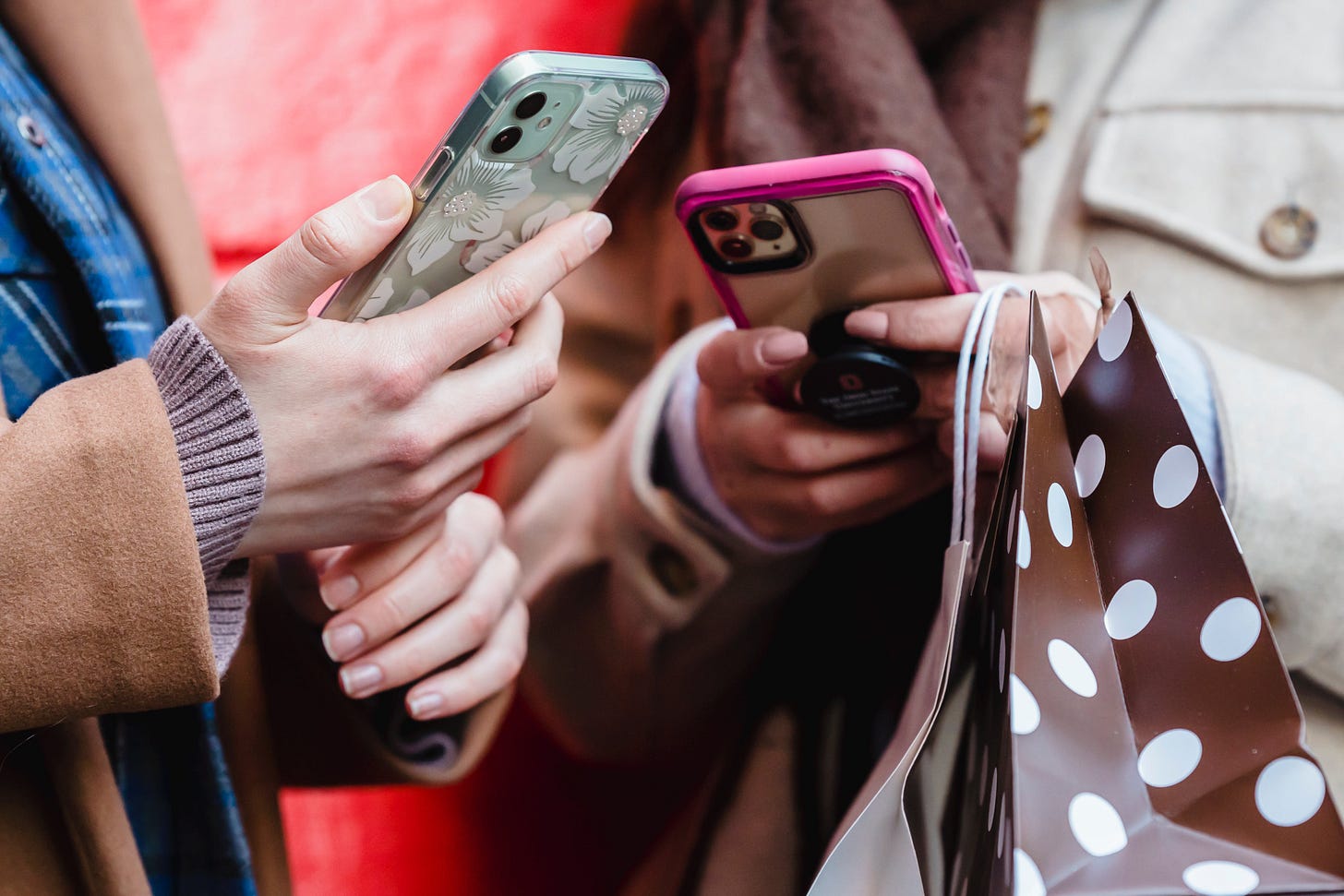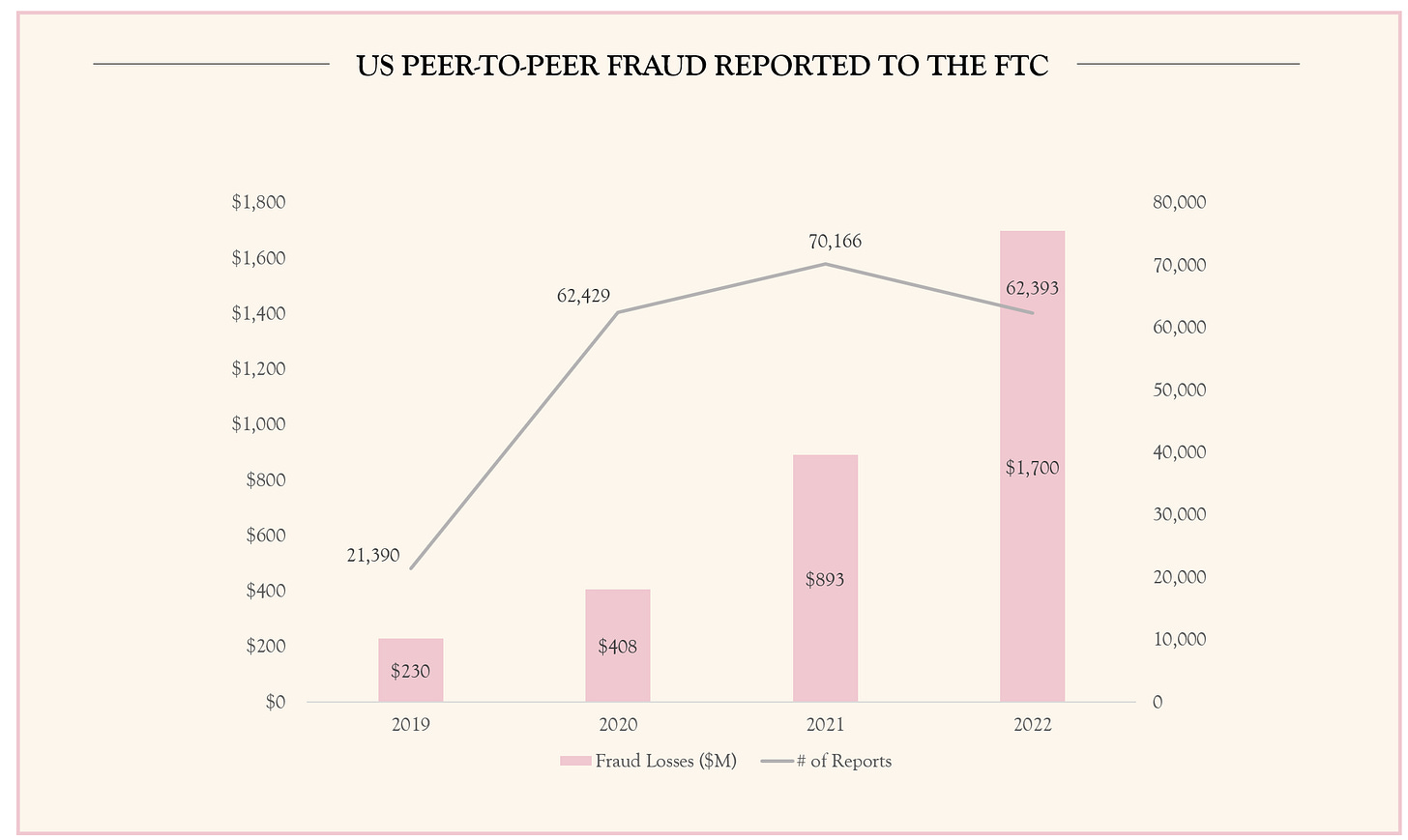If you ask most Gen Zs about how they split their dinner bill, pay their roommate for a cable bill, reimburse a friend, or even pay their rent, their preferred payment method is Venmo. All they have to do is pull out their phone, open up the Venmo app, pick their recipient from their contact list (or add them using their email or phone numbers), fill out the amount they want to send and hit send, and magically the money appears in their recipient’s Venmo account.
Venmo is one of the popular peer-to-peer (P2P) payment apps, which has simplified the sending and receipt of money. Before P2P payments apps, customers had to withdraw cash or write a check, and then figure out a way to get the payment to the recipient.

In this post, we will explore the history of P2P payments apps, including what P2P payments are, how these apps work, popular P2P payment apps and how fraud and scams are a big concern amongst P2P payments.
What are P2P Payments?
Peer-to-peer payments, also known as P2P payments, let consumers send money directly to or receive money from another person using a linked bank account, debit card or credit card. The payments are mediated through a P2P payment system, some of which come with their own apps (e.g., Venmo, PayPal, CashApp) or are within their banks or credit union’s app or online banking website (e.g., Zelle).
P2P 1.0
PayPal was the first P2P service that was introduced in the late 1990s and helped pave the way for e-commerce through use on eBay and other online retailers. To make or receive a payment, users had to create a PayPal account and link it to their bank account or card. While PayPal is closely associated with the advent of e-commerce and is thought of more as a digital wallet to enable online purchases, it also had a P2P payment functionality. Users could use PayPal send to or receive money from other individuals, but it was only accessible via a desktop computer.
P2P 2.0
With the emergence and proliferation of smartphones, the next generation of P2P services started to gain traction through their mobile apps. P2P services like Venmo (launched in 2009) and CashApp (launched in 2013) helped drive the volume of P2P payments due to the easy accessibility and the speed with which funds were received (i.e., funds show up instantly in the receiver’s P2P service account).
Banks developed their own P2P service, called Zelle in 2017 to capture the fast-growing P2P market. Unlike the other P2P service standalone apps, users could use Zelle within their banking mobile app (or online banking platform).
P2P Today
Today, P2P platforms are moving towards offering P2P payments as part of larger financial services ecosystem. PayPal bolstered its financial services platform with the acquisition of Braintree and Venmo in 2013, though Venmo is still operated as a separate app experience from PayPal.
Meanwhile, Apple launched Apple Cash in 2017, along with a slew of other financial services (Apple Wallet, Apple Card, Apple Buy Now Pay Later). Zelle moved beyond P2P payments, offering customers options to pay small business and receive money from larger businesses (i.e., disbursements) in the early 2020s.
According to Insider Intelligence, by the end of 2023 the US P2P market was estimated to transact $1.152T via mobile apps, primarily driven by Venmo, Zelle and CashApp.

How P2P Payments Work
P2P payments work by connecting the sender and recipient through an app or website. The sender enters the amount they want to pay as well as a social token, such as the recipient’s email address or phone number. The funds are transferred into the recipient’s account directly from the sender’s linked bank account, debit card or credit card, usually within minutes.
P2P platforms actually use a variety of methods to transfer funds between accounts. Some P2P platforms, like PayPal and Venmo use ACH transfers to send money via a linked bank account. The funds will appear “instantly” in the recipient’s PayPal or Venmo account. Once the funds appear in the recipient’s account, they can choose whether to use the balances in their account to make payments or they can choose to transfer the money to their actual bank account.
Most of the P2P platforms will allow the recipient to keep the funds in their P2P account (instead of transferring them into their bank account). This way, the recipient can use the funds in their P2P app to pay others. According to Nerdwallet, 46% of user will keep $100+ in their accounts, with customers keeping an average of $285 in their P2P accounts before transferring it to their bank account.
If the recipient chooses to move money to their actual bank account, it takes a few days for the funds to move into the bank account. Moving funds on the P2P platforms via ACH is free within the same country, though Venmo also offers the option to move funds into the actual bank account over the real-time payment rails for a fee.
Growth of popular P2P Payment Platforms
In the US, the most popular P2P platforms are Venmo (which is owned by PayPal), Zelle and CashApp.
Venmo is a significant player in the P2P market with the largest market share (by users) and an estimated 95.3M users in the US in 2023. Its user-friendly design, social features and the flexibility to send and receive money via various methods (e.g., linked bank account, debit card, credit card, or Venmo balance) has made it popular with the younger generation.
CashApp by Square is another popular P2P platform with an estimated 48M users in the US in 2023. Although it was originally launched to facilitate business transactions, it moved into the P2P space. One of Cash App’s unique selling points is its integration with Bitcoin, allowing users to buy, sell, and store the cryptocurrency directly within the app.
Zelle is a P2P platform backed by the largest US banks and has seen tremendous growth with an estimated 56.9M users in the US in 2023. Unlike Venmo and CashApp, Zelle is not a standalone app - it sits within the banking mobile app. More than 2,000 banks and credit unions offer Zelle to their customers, and
it allows for quick and direct bank-to-bank transfer. Customers tend to use Zelle for bill payments and larger transactions, such as rent given its unique integration with the banking mobile app.
There are other P2P offerings that are part of a larger payment ecosystems, such as PayPal and Apple Cash. These offerings make a smaller portion of the pure P2P market in the US.
Benefits of Using P2P Payment Platforms
P2P Payment platforms have gained popularity, because they offer several benefits, such as:
👍 Convenience: P2P payments app makes it easy to send payments as long as both the sender and the receiver are using the same platform. With the convenience of the P2P platforms, it reduces or eliminates the need to write checks, carry cash or request bank details.
✨ Easy to use: Sending money through bank transfer requires the sender to remember the recipient’s bank account details. P2P platforms only require a social token for the recipient (e.g., email address or phone number), making it much easier to send money. Additionally, sending money with the P2P platform only requires a few taps on a mobile device.
💨 Speed: With P2P payments platforms, funds are typically available immediately. Recipients can use the balances in their P2P payment apps to send money, though it typically takes a few days for the money to appear in their bank account.
Note: Zelle is the exception, since the funds will show up in the recipient’s bank account, without the need for any transfers.
P2P Payments and Fraud
One of the biggest risks in using P2P payments apps is the security concerns associated with fraud. According to the Deloitte, P2P fraud losses have rapidly increased in recent year, with the total P2P fraud losses reaching an estimated $1.7B in 2022, a 90% increase over 2021. Meanwhile, complaints to the Consumer Financial Protection Bureau (CFPB) regarding P2P payments apps increased 164% between 2019 and 2021.
P2P fraud losses on the Zelle platform have put the largest US banks in the crossfire of the regulators. According to a report published by U.S. Senator Elizabeth Warren (D-Mass), the total Zelle fraud losses totaled $255M in 2022 resulting from 238K P2P fraud cases at the big banks.
In general, there are two types of fraud:
Unauthorized fraud (i.e., fraud) are generally initiated by individuals who are not the actual customer, but who have obtained controls of accounts, credentials, or identities to send funds
Authorized fraud (i.e., scams) are generally transactions that have authorized by the customer themselves, but the customer has been unknowingly tricked into transferring the funds
In the case of most P2P payment app, customers are protected in the event of unauthorized fraud. For example, banks provide full refunds for any Zelle transaction that are unauthorized (as defined in the Electronic Fund Transfer Act (EFTA) and Regulation E) and PayPal has a 180-day refund window for unauthorized transactions.
However, the P2P payments apps typically don’t provide coverage or refunds where the funds are sent to the wrong person or more importantly in situations where the customer is the victim of a scam. What makes it so challenging is that the nature of the scams are constantly evolving due to consumer awareness and new technologies. In fact, according to the Federal Trade Commission (FTC), scams from P2P payments (and other payments) comprised of the top five fraud losses in 2021: imposter scams ($2.3 billion); online shopping scams ($392 million); prizes, sweepstakes and lotteries ($255 million); internet services ($216 million); and business and job opportunities ($206 million).
Risk of P2P payment Balances
In addition to the risks of fraud and scams, there are risk associated with the balances in the P2P payment apps. Customers may perceive the balances that are stored in a P2P payment apps act like a traditional deposit account. However, in general P2P payment apps are provided by companies that do not carry Federal Deposit Insurance Corporation (FDIC) or a National Credit Union Association (NCUA) insurance. As a result, if the nonbank P2P payment apps were to go bankrupt, customers may be at risk of losing their funds or experience delays in accessing funds while the bankruptcy process unfolds.
Note: Zelle is the exception, since funds are held in a bank account that is FDIC or NCUA insured
Can P2P Payments Morph into Digital Wallets or Banking?
As P2P payments have gained more popularity, the P2P market has become saturated. As a result, the P2P payment platforms have started to evolve beyond the traditional P2P offerings into other financial services. For example, Venmo introduced business profiles in their app in 2021, and announced business profile enhancements, indicating that there are targeting the consumer to business (C2B) payments, especially in the small business space.
Additional, digital wallet players, like Apple have introduced their own P2P payment solutions. In 2017, Apple introduced Apple Cash, its P2P payment offering, which allows customers to send or receive money from other iOS users through the Apple Cash Card. The Apple Cash offering sits within their larger payments ecosystem (Apple Wallet).
It is clear that the lines have started to blur between pure P2P payments apps and other financial offerings. As fintechs, big tech and banks compete for consumer relationship primary, it is feasible for P2P payment apps to sit within either digital wallets or evolve to look more like banks.








Nice article.
I was always confused whether Zelle would come under P2P or not. Thank you for making it clear and highlighting the exception Zelle has.